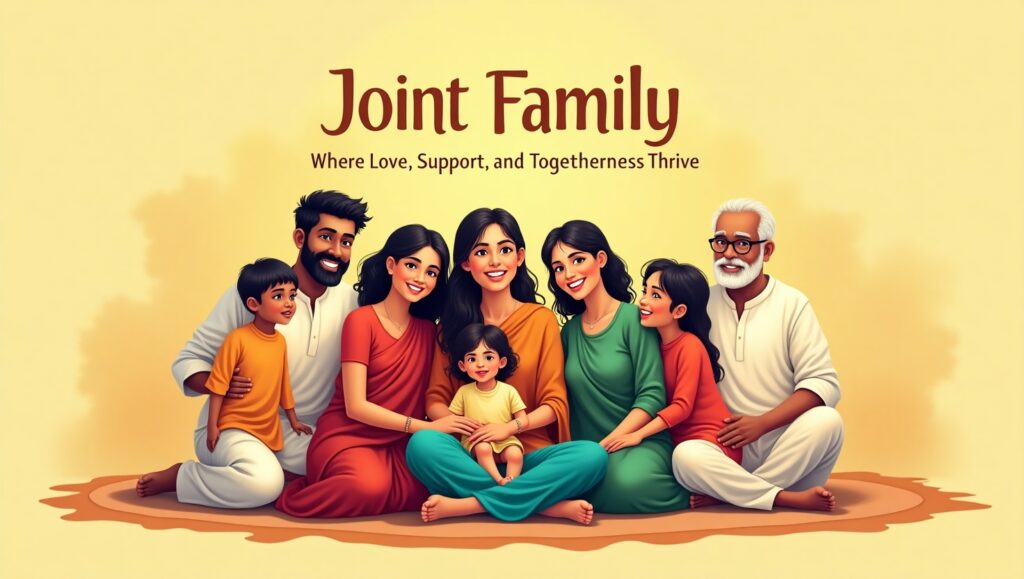Discover the significance of a joint family, where multiple generations live under one roof, fostering unity, support and shared responsibilities. Learn about the advantages, challenges and how joint families create a strong foundation for emotional and financial stability.
Although a joint family system may seem obsolete, it is still alive due to its cultural as well as emotional significance. A joint family system incorporates multiple generations including, grandparents, parents, children and even uncles, aunts, and cousins living together under one roof. This system reflects the core values of togetherness, sharing, and taking care of one another. In this article, we will explore the essence of a joint family, its advantages, challenges, and why it remains relevant today.
What is a Joint Family?
A joint family is a member of an extended family that incorporates two or more generations cohabiting and sharing a common location, posses resources, responsibilities, and emotional connections. This family structure generally consists of:
- Grandparents
- Parents
- Children
- Uncles, Aunts and Cousins
In a joint family, family members share living costs as well as responsibilities which help build unity. Family members often discuss decisions together and elders take the opportunity to advise the younger family members. An extension family like this is prevalent in India where family values and traditions are strongly emphasized.
History and Cultural Significance of Joint Families
Joint Families have been a cultural feature for many Indian families from the ancient times. The concept of “Vasudhaiva Kutumbakam” suggests that living together as a family provides a conducive life as one’s value and responsibilities are shared. Consequently, this accentuates the significance of harmony and oneness among all.
Economically backward societies heavily depended on joint families because of protective rural agricultural economies where members split their responsibilities like working on the fields, harvesting and even tough situations. This system existed within other cultures like China and Japan where familial bonds and support were critical for the social order and stability.
Benefits of Joint Families
Due to the strong bonds, there is emotional and financial stability when living in a joint family:
a) Emotional Support and Stability
Interpersonal connections are top-notch in a joint family structure. Family members come together to provide guidance and support during difficult situations. Owing to these dynamics, children are able to grow up in a loving and healthy environment.
b) Financial Security
Joint families often combine their finances enabling them to spend comfortably. With the reduced costs of supporting one’s self, financial stability is ensured along with meeting the fundamental requirements.
c) Collective Contributions
All family members share the workload of housework as well as caring for both children and the elderly. This fosters harmony while making certain that no one person is overburdened.
d) Improved Child Rearing
Joint families enable children to be mentored by grandparents and other senior relatives. They also tend to learn value traits like civility, tolerance, and cooperation from an early stage.
e) Deepened Affection Among Relatives
The intimate gathering of relatives enables them to foster deeper relationships with each other. Such relationships are deepened by family occasions, family dinners and other bonding activities.
Challenges of a Joint Family
The numerous pros of a joint family structure are accompanied by a few cons, as outlined below:
a) Everyone’s Business is A Shared Business
In a joint family setup where multiple families live under a single roof, windows of privacy tend to get smaller. Space and freedom in which individuals may move feel limited.
b) Clashes and Differences
Having distinct views, ways of life, or spending habits and money can be the beginning of a problem. Finding reasonable solutions in such cases is ever somewhat difficult and means communication and compromise.
c) Imbalance in Workload Allotment
In certain instances, some people feel that they are doing much more than their fair share of work at home or paying at the family level other expenses. This can lead to conflict and hostility among family members.
d) Age Differences
Outdated and new aged systems will always collide causing confusion and chaos in a family joint system.
Role of Elders in a Joint Family
Elders play a pivotal role in a joint family. They act as guides, resolving conflicts and providing emotional and moral support. Their wisdom and life experience help in shaping the younger generation’s values and outlook toward life. The presence of elders also creates a sense of security and stability within the family.






